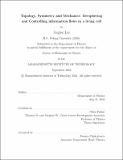Topology, Symmetry and Mechanics: Deciphering and Controlling information flows in a living cell
Author(s)
Liu, Jinghui
DownloadThesis PDF (33.61Mb)
Advisor
Fakhri, Nikta
Terms of use
Metadata
Show full item recordAbstract
Living organisms collect, preserve and transform information on complex spatiotemporal bases. Take a living cell for instance, the signaling proteins are capable of forming patterns on lengths that are tens of thousands the molecular size. During force-generating processes such as cell divisions, both the spatial and temporal aspects of protein patterning convey essential physiology outcomes.
While many advances focusing on the molecular complexity of such chemomechanical interactions have been made in recent years, it remains unclear to what extent they can be described and even predicted with the language of a physicist. That is, to decipher the structure and dynamics of the cellular information flows focusing on system-level topology and symmetry signatures, rather than the molecular and kinetic specificities. Taking a step further, with emerging experimental tools that allow for quantitative controls over the molecular interactions, the engineering of information flows towards violation of system-level physical symmetry remains an open pursuit.
In this thesis, I present a series of studies in the chemomechanical Rho-actomyosin signaling process that takes place in P. Miniata starfish egg cells. In Chapter 1, I review this model system for its molecular components and physiological functions, highlighting the need of novel order parameters for characterizing the complex biochemical and biochemical changes. In Chapter 2, I show that the statistics and dynamics of topological defects embedded in Rho chemical patterns can be drawn an unexpected parallel to classical and quantum turbulent fluids. In Chapter 3, I further demonstrate a Bosonic symmetry between braided topological defects as well as the emergence of pair-scattering virtual particles on the cell membrane during signaling. In Chapter 4, I develop an optogenetic-based tool recruiting Rho-activating enzyme and use light to quantitatively control surface contraction waves that override wild type guiding cues and violate pole symmetry. In Chapter 5, I discuss the use of vibrational sound microscopy on non-invasively probing active fluctuations in the force-generating cell cortex. Finally, I conclude in Chapter 6 by discussing investigation of room-temperature novel physics in biological systems combining advanced biological tools and a condensed-matter theoretical approach.
Date issued
2022-09Department
Massachusetts Institute of Technology. Department of PhysicsPublisher
Massachusetts Institute of Technology